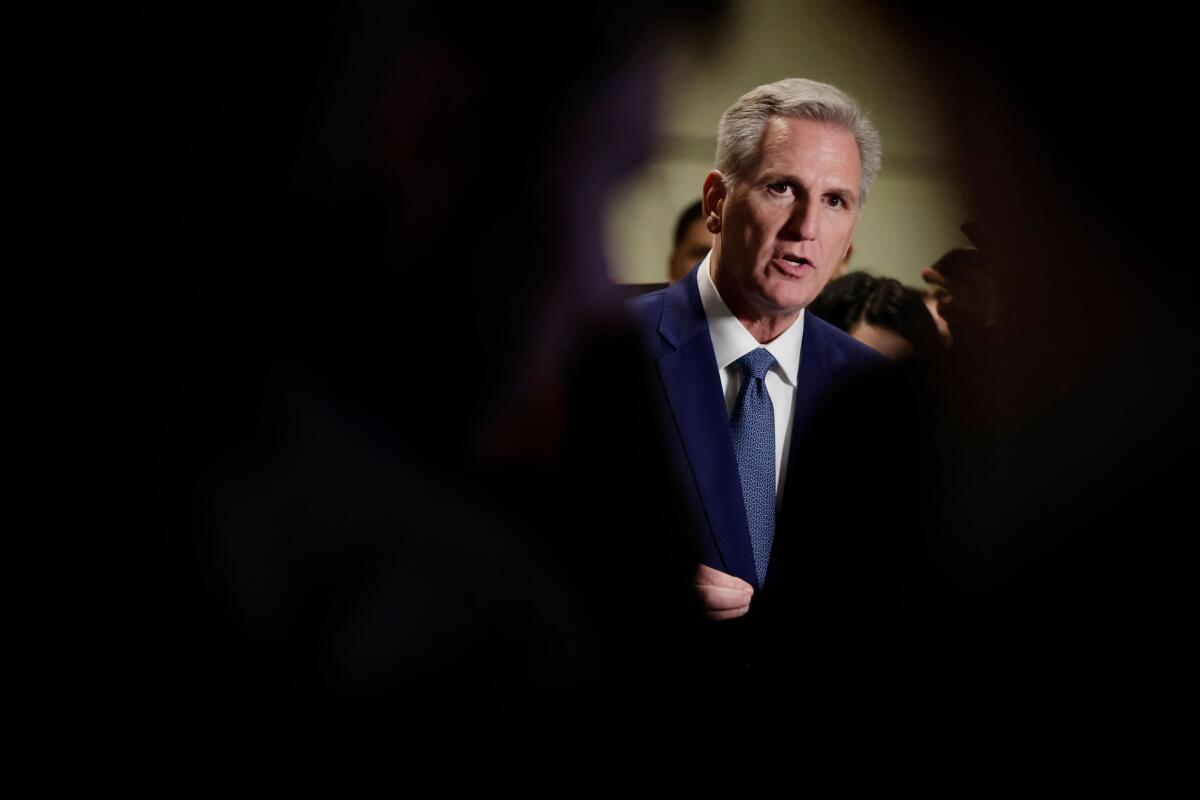Republicans, including ‘cowardly’ Schwarzenegger, take heat for Proposition 50’s lopsided loss
Republican infighting crescendoed in the aftermath of California voters overwhelmingly approving Democratic-friendly redistricting plan this week that may undercut the GOP’s control of Congress and derail President Trump’s polarizing agenda.
The state GOP chairwoman was urged to resign and former Republican Gov. Arnold Schwarzenegger, who championed the creation of the state’s independent redistricting commission, was called “cowardly” by one top GOP leader for not being more involved in the campaign.
Leaders of the Republican-backed committees opposing the ballot measure, known as Proposition 50, were questioned about how they spent nearly $58 million in the special election after such a dismal outcome.
Former House Speaker Kevin McCarthy of Bakersfield, the once prodigious Republican fundraiser, reportedly vowed earlier in the campaign that he could raise $100 million for the opposition but ended up delivering a small fraction of that amount.
Assemblyman Carl DeMaio (R-San Diego), a conservative firebrand, called on state GOP chair Corrin Rankin to step down and faulted other Republican leaders and longtime party operatives for the ballot measure’s failure, calling them “derelict of duty and untrustworthy and incompetent.”
“Unless serious changes are made at the party, the midterms are going to be a complete disaster,” DeMaio said, also faulting the other groups opposing the effort. “We need accountability. There needs to be a reckoning because otherwise the lessons won’t be learned. The old guard needs to go. The old guard has failed us too many times. This is the latest failure.”
Rankin pushed back against the criticism, saying the state party was the most active GOP force in the final stretch of the election. Raising $11 million during the final three weeks of the campaign, the party spent it on mailers, digital ads and text messages, as well as organizing phone banks and precinct walking, she said.
Former Speaker of the House and California Republican Kevin McCarthy speaks to the press at the U.S. Capitol in Washington, D.C., on Oct. 19, 2023.
(Samuel Corum / AFP via Getty Images)
“We left it all on the field,” Rankin said Wednesday morning at a Sacramento press conference about a federal lawsuit California Republicans filed arguing that Proposition 50 is unconstitutional. “We were the last man standing … to reach out to Republicans and make sure they turned out.”
Responding to criticism that their effort was disorganized, including opposition campaign mailers being sent to voters who had already cast ballots, Rankin said the party would conduct a post-election review of its efforts. But she added that she was extremely proud of the work her team did in the “rushed special election.”
Barring successful legal challenges, the new California congressional districts enacted under Proposition 50 will go into effect before the 2026 election. The new district maps favor Democratic candidates and were crafted to unseat five Republican incumbents, which could erase Republicans’ narrow edge in the the U.S. House of Representatives.
If Democrats win control of the body, Trump policy agenda will likely be stymied and the president and members of his administration cold face multiple congressional investigations.
Gov. Gavin Newsom and other California Democrats proposed Proposition 50 in response to Trump urging elected officials in Texas and other GOP-led states to redraw their congressional districts to increase the number of Republicans elected to the House next year.
The new California congressional boundaries voters approved Tuesday could give Democrats the opportunity to pick up five seats in the state’s 52-member congressional delegation.
Proposition 50 will change how California determines the boundaries of congressional districts. The measure asked voters to approve new congressional district lines designed to favor Democrats for the 2026, 2028 and 2030 elections, overriding the map drawn by the state’s independent redistricting commission.
Some Republicans lamented that Schwarzenegger was not more involved in the election. The movie star championed the creation of the independent commission in 2010, his final year in office. He campaigned for the creation of similar bodies to fight partisan drawing of district lines across the nation after leaving office.
Shawn Steel, one of California’s three representatives on the Republican National Committee, called Schwarzenegger “a cowardly politician.”
“Arnold decided to sit it out,” Steel said. “Arnold just kind of raised the flag and immediately went under the desk.”
Steel said that the former governor failed to follow through on the messages he repeatedly delivered about the importance of independent redistricting.
“He could have had his name on the ballot as a ballot opponent,” Steel said. “He turned it down. So I’d say, with Arnold, just disappointing, but not surprised. That’s his political legacy.”
Schwarzenegger’s team pushed back at this criticism as misinformed.
“We were clear from the beginning that he was not going to be a part of the campaign and was going to speak his mind,” said Daniel Ketchell, a spokesman for the former governor. “His message was very clear and non-partisan. When one campaign couldn’t even criticize gerrymandering in Texas, it was probably hard for voters to believe they actually cared about fairness.”
Schwarzenegger spoke out against Proposition 50 a handful of times during the election, including at an appearance at USC that was turned into a television ad by one of the anti-Proposition 50 committees that appeared to go dark before election day.
On election day, he emailed followers about gut health, electrolytes, protein bars, fitness and conversations to increase happiness. There was no apparent mention of the Tuesday election.
The Democratic-led California Legislature in August voted to place Proposition 50 on the November ballot, costing nearly $300 million, and setting off a sprint to Tuesday’s special election.
The opponents were vastly outspent by the ballot measure’s supporters, who contributed nearly $136 million to various efforts. That financial advantage, combined with Democrats’ overwhelming edge in voter registration in California, were main contributors to the ballot measure’s success. When introduced in August, Proposition 50 had tepid support and its prospects appeared uncertain.
Nearly 64% of the nearly 8.3 million voters who cast ballots supported Proposition 50, while 36% opposed it as of Wednesday night, according to the California Secretary of State’s office.
In addition to the state Republican Party, two main campaign committees opposed Proposition 50, including the one backed by McCarthy. A separate group was funded by more than $32 million from major GOP donor Charles Munger Jr., the son of a billionaire who was Warren Buffet’s right-hand man, and who bankrolled the creation of the independent congressional redistricting commission in 2010.
Representatives of the two committees, who defended their work Tuesday night after the election was called moments after the polls closed, saying they could not overcome the vast financial disadvantage and that the proposition’s supporters must be held to their promises to voters such as pushing for national redistricting reform, did not respond to repeated requests for comment on Wednesday.
Newsom’s committee supporting Proposition 50 had prominent Democrats stumping for the effort, including former President Obama starring in ads supporting the measure.
That’s in stark contrast to the opposition efforts. Trump was largely absent, possibly because he is deeply unpopular among Californians and the president does not like to be associated with losing causes.

